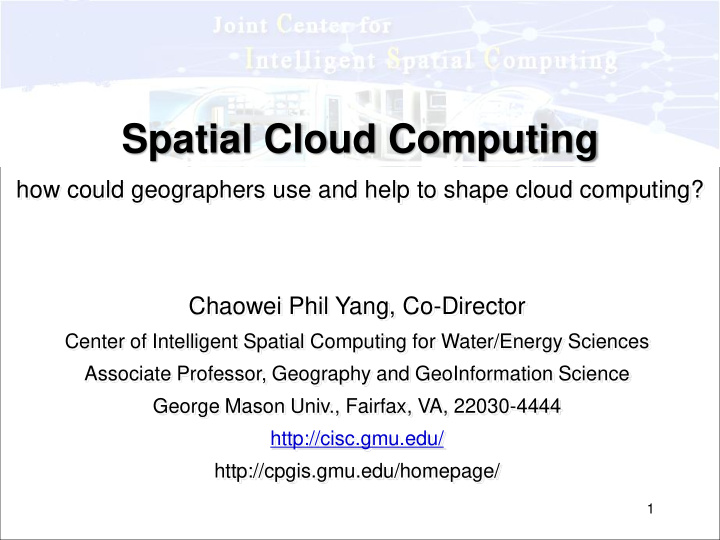



Spatial Cloud Computing how could geographers use and help to shape cloud computing? Chaowei Phil Yang, Co-Director Center of Intelligent Spatial Computing for Water/Energy Sciences Associate Professor, Geography and GeoInformation Science George Mason Univ., Fairfax, VA, 22030-4444 http://cisc.gmu.edu/ http://cpgis.gmu.edu/homepage/ 1
Geographic Science Information Workflow IT Characteristics: Data Intensity Computing Intensity Concurrent Access Intensity, and Spatiotemporal Intensity
Data Intensity An example with NASA Data as a Service
Computing Intensity An example with Dust storm forecasting
Concurrent Intensity An example with GEOSS Clearinghouse
Spatiotemporal Intensity example with near real-time routing A metropolitan region such as D.C., static routing • 86697 nodes, 204201 links • 86697*86696 potential OD (origin and destination) • Fixed best route for each OD request pair • All of the routing solutions data volume <1 Gb Dynamic real time routing, keep historical data • Changes every minute for each link and node. • Volume increases by 24X60 = 1.3k for a daily basis • 24x60x7 = 10k for a weekly basis • 24x60x365 = 0.5 M for a yearly basis More important, there’s no algorithm to handle this problem practically yet
Spatial Cloud Computing Spatial Cloud Computing refers to the computing paradigm that is driven by geospatial sciences, and optimized by spatiotemporal principles for enabling geospatial and other science discoveries within distributed computing environment. Yang C., Goodchild M., Huang Q., Nebert D., Raskin R., Xu Y., Bambacus M., Fay D., 2011 (in press), Spatial Cloud Computing: How geospatial sciences could use and help to shape cloud computing? International Journal on Digital Earth
Spatial Cloud Computing Architecture
Spatial Cloud Computing Issues 1. Spatiotemporal principle mining and extracting 2. Important Digital Earth & complex geospatial science and applications 3. Supporting the SCC characteristics 4. Security 5. Citizen and social science issues: Trustworthy, Privacy, Ethical, etc.
Acknolwedgements Partially supported by • NASA (NNX07AD99G and SMD-09-1448), • FGDC (G09AC00103), and • Microsoft Research Connection’s Earth, Energy, and Environment Program. Discussed with colleagues from • NASA • FGDC/USGS • EPA • GSA • Microsoft • ESIP • AAG CISG • CPGIS • UCGIS • ISDE
Recommend
More recommend